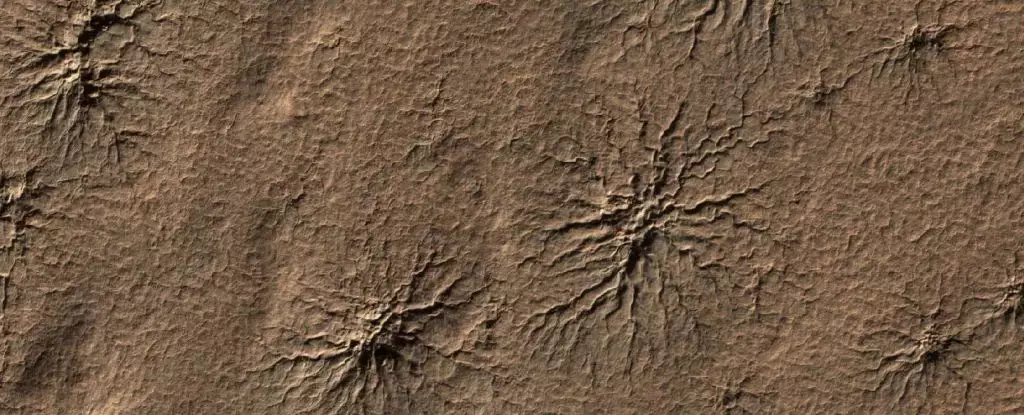Mars, the crimson neighbor often associated with intrigue and unyielding landscapes, harbors a peculiar phenomenon that captivates scientists and enthusiasts alike: the so-called “Martian spiders.” Characterized by their distinctive tendrilled shapes that appear under the planet’s unique conditions, these formations have sparked curiosity and debate concerning their origins and implications for understanding surface processes on Mars. As researchers delve deeper into this enigma, new experiments provide insights that could bridge the gap between Earthly geology and Martian anomalies.
The term “araneiform” derives from the Latin word for spider, aptly illustrating the resemblance of these formations to arachnids as they stretch across the Martian landscape. Revealed through high-resolution satellite imagery, these intriguing features manifest prominently in Mars’ southern polar region during the Martian spring, appearing as delicate networks of dark troughs. Yet, they are not living creatures; instead, they are sculpted by the interaction of sublimated carbon dioxide and Martian dust. Understanding these formations provides critical insight into the seasonal geological processes occurring on Mars, highlighting stark differences between its surface dynamics and those of Earth.
The emergence of araneiforms has challenged researchers for years, as the precise mechanisms behind their formation remained elusive until recent laboratory recreations provided a clearer picture. Scientific teams, motivated to unveil the processes shaping Martian landscapes, turned to innovative experimental techniques to probe deeper into the Martian spring’s complex conditions.
Hugh Kieffer, a geophysicist, introduced a compelling hypothesis in the 2000s, suggesting that araneiforms arise due to the intense thermal dynamics associated with carbon dioxide ice. On Mars, where winters plunge temperatures low enough to freeze atmospheric CO2, this element undergoes a process that does not exist on Earth. Unlike terrestrial conditions where CO2 usually transitions between liquid and gas states under pressure, on Mars, frozen CO2 sublimates directly into gas, creating unique geologic phenomena.
At the core of Kieffer’s theory lies the seasonal cycle: during frigid winters, carbon dioxide accumulates in solid form on the Martian surface, only to transform into gas as spring temperatures rise. As darker Martian soil heats from below, pockets of gas form underneath the solid CO2 layer, generating pressure that ultimately leads to explosive releases. These events leave behind dark scars, resembling spider-like shapes, etching the Martian landscape each spring.
In pursuit of replicating this geological process, scientists at NASA’s Jet Propulsion Laboratory employed a sophisticated experimental setup dubbed the Dirty Under-vacuum Simulation Testbed for Icy Environments (DUSTIE). This chamber was meticulously designed to mimic Mars’ atmospheric pressure and temperature, allowing researchers to cool a Mars regolith simulant with liquid nitrogen. Following this, carbon dioxide was introduced, leading to a fascinating interplay between gas and solid states.
The excitement of discovery ignited when the researchers eventually observed that the simulated ice would literally explode, mirroring the enigmatic dynamics of the Martian surface. Contrary to earlier assumptions that gas would escape from beneath a layer of ice resting atop the soil, the team found that the gas actually formed within the dirt itself. As a result, the explosive release left cracks originating from depths rather than merely impacting the surface. This revelation not only reinforces the Kieffer model’s validity but also signifies a novel understanding of how seasonal features develop on Mars.
The successful reproduction of araneiforms in the laboratory represents a significant stride towards clarifying the geological features of Mars. As researchers continue fine-tuning their experiments, the implications extend beyond merely acknowledging the presence of these spiders. Understanding the mechanics behind such seasonal changes is crucial for unraveling Mars’ geological history and its climatic variations over time.
While the prospect of discovering life beyond Earth remains an enduring subject of fascination, the revelations surrounding Martian spiders orbit much deeper implications about planetary processes and environmental conditions. The synergy of innovative technologies and scientific inquiry has painted a clearer picture of even the most enigmatic features dotting the Martian surface.
In future studies, scientists will undoubtedly pursue an even more detailed analysis of these formations, potentially laying a foundation for understanding not only Mars but the broader cosmic landscape. The Martian spiders, once a mere curiosity, now stand as a testament to the complexity of planetary processes, waiting for further exploration that could unveil more surprises about our solar system’s intricacies.

